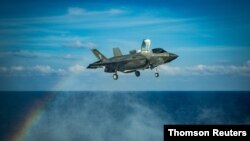The U.S. Navy is sending an increasingly obvious number of ships into a disputed Asian sea to prove that COVID-19 won’t stop it from resisting China’s maritime expansion, observers say.
U.S. Cold War foe China, which claims about 90 percent of the South China Sea, never halted military activities in the resource-rich tropical sea, despite the disease outbreak in its own country. Washington now wants its Asian allies – smaller countries fearful of China’s reach – to know they have not been forgotten as the pandemic rips through the United States, analysts say.
“There is certainly an incentive to pack these activities on a back-to-back basis and make it more visible and gain more high intensity just to show they are in business,” said Collin Koh, maritime security research fellow at Nanyang Technological University in Singapore.
Washington sends ships into the South China Sea every year, and activity picked up after President Donald Trump took office in 2017.
“China’s propaganda has been the U.S. government can’t control COVID and America is doing all this just to show it’s not weakened and declining and they’re just trying to bluff us,” said Carl Thayer, emeritus professor at the University of New South Wales in Australia, referring to Beijing’s view of the latest U.S. Navy movement.
An April 17 decision not to base bombers on the U.S. territory of Guam particularly raised questions about whether the U.S. military is “ready” for China or even “scared” of China’s People’s Liberation Army, Koh said.
Freedom of navigation operations
The U.S. Navy's littoral combat ship Montgomery passed near a disputed South China Sea island in January, the first publicized movement in that waterway this year. No operations were announced in February and March, an unusually wide gap. In late April, the Navy carried out two more South China Sea operations in as many days. Another pair of ships entered the sea May 7.
American officials call the passages freedom of navigation operations and regard the South China Sea as an internationally open waterway despite China’s exclusive claims to much of it.
“Through continued operational presence in the South China Sea, the U.S. Navy supports transparency, the rule of law, freedom of navigation and overflight, the principles that underpin security and prosperity for the Indo-Pacific, so that all nations in the region may benefit,” the Navy said in a statement that day.
U.S. Pacific Fleet spokesperson Lt. James Adams confirmed four freedom of navigation operations this year so far and called the U.S. naval presence “near continuous.”
“All of our operations … demonstrate the United States will fly, sail, and operate wherever international law allows – regardless of the location of excessive maritime claims and regardless of current events,” Adams said.
Fisheries, undersea energy reserves
Brunei, China, Malaysia, the Philippines, Taiwan and Vietnam claim all or parts of the 3.5 million-square-kilometer sea that’s valued for fisheries and undersea energy reserves. China has taken a military lead over the others since 2010 by building up some of the sea’s larger islets, sparking opposition from the United States.
The Southeast Asian countries will privately rejoice at the return of U.S. ships, Koh said. Over the past year, Malaysia, Vietnam and the Philippines have run up against Chinese ships in waters they claim.
U.S. officials returned to the South China Sea partly to ease fears around Asia about China’s expansion, said Huang Chung-ting, an assistant research fellow with the Institute for National Defense and Security Research in Taipei.
“One aspect is to give [a signal to] normal people in surrounding countries or Taiwan where China has waged psychological warfare,” Huang said. The Navy ship passages, he said, “continue support and offset earlier when the United States wasn’t there.”








